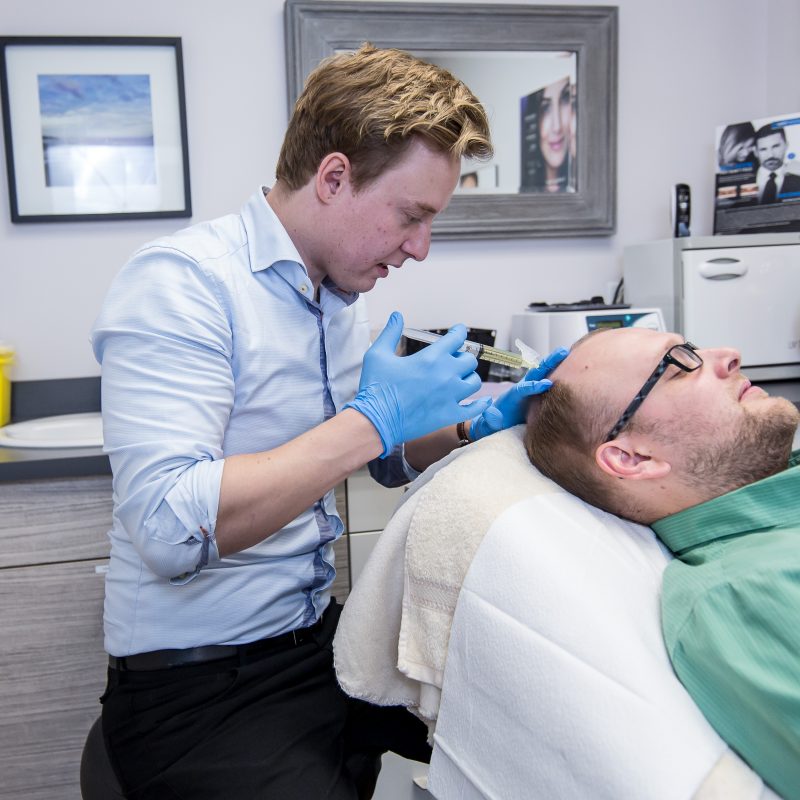Four ways to treat male pattern baldness
Male pattern baldness, also called androgenic alopecia, is the most common type of hair loss in men. It affects about 16% of men aged 18-29, 53% of men older than 40, and 80% of men older than 80.[2] It is characterized by gradual hair loss, hair thinning and reduced rate of growth.
What causes male pattern baldness?
Hair loss can be attributed to both genetics and hormones.
If both of your parents have thinning hair or are blading, chances are you will inherit these traits. It is commonly thought that there is a greater genetic contribution from the maternal side, but this isn’t always the case. There are many genes responsible for hair loss and there is no way to fully determine your scalps future.
Sex hormones (androgens) also play a substantial role. The most potent sex hormone that impacts hair growth is called Dihydrotestosterone (DHT). DHT is produced from testosterone via an enzyme called 5-alpha-reductase, which is found in high concentrations in the scalp. Individuals who are genetically predisposed to androgenic alopecia have high enzyme concentrations which increases DHT levels around the hair follicle cells. Long term exposure to high levels of DHT leads to scalp hair follicle miniaturization, increased hair shedding, decreased rate of hair growth and decreased hair diameter.
Options to address hair loss
While hair loss can’t be fully prevented, there are steps you can take to slow down hair loss and restore hair growth in balding areas of the scalp.
Here are the top four suggested medical treatments for androgenic alopecia:
-
Minoxidil (Rogaine): This is a prescription strength topical that may be helpful to reduce the rate of hair loss, primarily for the receding hairline.
-
Oral Finasteride (Propecia): This medication was originally developed to help treat enlarged prostates. It acts as a 5-alpha-reductase inhibitor, preventing the conversion of testosterone to its super potent androgen, DHT. By reducing levels of DHT, there is less hair loss. After three to six months of treatment, there will be new hair growth (particularly on the crown). However, not all patients respond to this medication and it carries a 2% risk of decreased libido or sexual dysfunction. Additionally, when this medication is stopped, you will likely lose the new hair growth within 12 months.
-
Platelet rich plasma (PRP): This is a treatment where a vial of your blood is taken and then spun at a high speed (in a centrifuge) to separate your blood into two layers: plasma and red blood cells. The plasma layer has a high concentration of platelets which contain numerous growth factors. These growth factors are injected into the scalp to induce new hair growth, improve density, quality and rate of growth of new hairs[1].This treatment is repeated about once a month for three months and then every three to six months afterwards. PRP has been shown to decrease hair loss and also increase the thickness and density of the hair.
-
Hair transplant: This is a surgical procedure and involves harvesting hair follicles from the back of the head and then implanting them in the front and mid scalp.
If you are noticing hair loss or thinning, it’s recommended you speak with a physician to discuss your options and to rule out any underlying illness that may be reversible and contributing to accelerated hair loss. Hemingway Medical Spa offers PRP treatments for hair loss. A complimentary consultation can be booked by calling, 587-521-0667.
[1] Katsuoka K, Schell H, Wessel B, Hornstein OP. Effects of epidermal growth factor, fibroblast growth factor, minoxidil and hydrocortisone on growth kinetics in human hair bulb papilla cell and root sheath fibroblasts cultured in vitro. Arch Dermatol Res. 1987;279:247-250.
[1] Li ZJ, Choi HI, Choi DK, et al. Autologous platelet-rich plasma: a potential therapeutic tool for promoting hair growth. Dermatol Surg. 2012;38:1047-1048.
[2] Rhodes T, Girman CJ, Savin RC, et al. Prevalence of male pattern hair loss in 18-49 year old men. Dermatol Surg. 1998;24(12): 1330-2.


